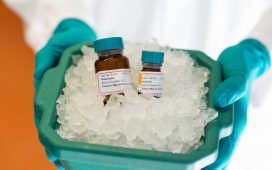I was back at the checkpoint. The traffic moved as normal. Bored-looking soldiers waved through civilians on foot, dusty cars and rickety trucks full of livestock and produce.
Then the Humvee in front of the gate blew up. Out of the eye-searing blast, I made out the figure of a man running at me, full-speed. He was wearing an explosive vest. I shot him.
A flash of movement to my left revealed a sniper who had just begun to raise his gun. I got him, too. Now a mass of people – maybe seven – breached the checkpoint. Bang-bang-bang.
There weren’t any more after that, only the quiet whistle of the desert wind. The lights came up and the tech walked in.
“How many did I get?” I asked, as I surrendered my rifle and headgear, cutting off the flow of electricity that had been coursing through my brain.
She shrugged. “All of them.”
I was in a grey office park in Southern California, nowhere near any checkpoint in any conflict. In my hands was an M4 close-combat rifle modified to fire harmless cartridges. The people I was firing at had been dreamed up by the programmers of a wall-sized army-training simulation. What was real was the electrical stimulation device on my head. I had signed up to have a few milliamps from a 9V battery sent through my skull to test if it would make me a better shot.
The scientists’ hypothesis was that the electrical current would recalibrate a different kind of electricity in my brain: the naturally occurring bioelectric signals that the nervous system relies on to communicate. By overpowering these delicate natural streams with an artificial shock to the executive part of my brain, they hoped to wrench my mind into a state of alertness and concentration – enough to turn this desk-slumping journalist into a battle-ready assassin.
I was obsessed from the moment I first caught wind of this military brain-stimulation experiment. I had seen this technique – known as transcranial direct current stimulation (tDCS) – bubbling around the science press for a few years. Among other intriguing results, it seemed to improve everything from treatment-resistant depression to poor maths skills.
This flow of electricity, according to the scientists who wired me up, might alter the strength of connections between the neurons in my brain, making them more likely to fire in concert. That natural synchronisation is the basis of all learning and speeding it up with an electrical field would theoretically accelerate the rate at which I could learn a new skill.
When I caught my first glimpse of this strange new use for electricity in 2009, it was the stuff of obscure medical trials and secret military projects. Today, the notion of wearing an electrical stimulator on your head is certainly the kind of thing you can imagine someone in Silicon Valley doing for a little extra mental edge, alongside intermittent fasting or microdosing psilocybin.
But it’s not just about boosting your brainpower with a volt jolt – there are many other ways electricity is being used to treat the ailments of body and mind. Take deep-brain stimulation, a treatment of last resort for Parkinson’s disease, in which two electrodes the size and shape of a strand of spaghetti are slid into the deepest parts of your brain to quieten the disease’s destructive symptoms.
In the wake of its fantastic success, scientists are testing the treatment on epilepsy, anxiety, obsessive-compulsive disorder and obesity. Then there’s the rise of “electroceuticals”: these rice-grain-sized electrical implants, clamped around nerves in the body, supposedly interrupt their signals and, in rat and pig trials, appeared to reverse diabetes, hypertension and asthma.
In 2016, outstanding early results in human trials, in which they seemed to reverse rheumatoid arthritis, convinced Google’s parent company, Alphabet, to team up with a pharmaceutical multinational on a £540m venture to tap into the body’s electrical signals, to try to treat diseases such as Crohn’s and diabetes.
So when I saw the opportunity to be a guinea pig in a US Department of Defense project, of course I jumped at it, and I wasn’t disappointed: my own experience with tDCS was transformative. Getting my neurons slapped around by an electric field instantly sharpened my ability to focus and, by the transitive property, my sharpshooting skills.
It also felt incredible – like someone had finally hit the off switch on all the distracting negative self-talk that had, until that moment, been the main provider of my mind’s elevator music. I had a tendency to get distracted from tasks by my own self-recriminations; this constant background chatter was such a ubiquitous feature of my mind that I had stopped noticing it, but it certainly got in the way of stressful tasks – including these shooting drills. My first taste of electricity felt as if someone had popped a bell jar over all those inner voices. Their sudden silence made me aware of the power they’d had.
When my story detailing the experience was published in New Scientist, it went viral. It was tapping into something zeitgeisty. Since the early 2000s, thousands of studies had pointed to tDCS as a way to improve the mind. The data and the headlines had been accumulating for years, but my gonzo experience took it out of dry, clinical stuff.
Seeing dollar signs in the combination of intriguing lab results and growing public interest, enterprising start-ups quickly began to hawk their own commercial versions of the brain-enhancing headgear I had road-tested. These cute wearables, which would set you back a few hundred dollars, had little in common with the £10,000 gear in the Department of Defense’s arsenal.
Nonetheless, they were soon adopted by people looking for any bit of extra mental edge, including high-level athletes. Before every game, the Golden State Warriors – a team so unbeatable they were accused of “ruining basketball” – wore them in practice sessions to zap their brains into the zone. The US Olympic ski team used headsets in training drills, raising accusations of “brain doping”.
And then came the inevitable backlash. Sceptics started to wonder if this was all a bit too good to be true. Soon a wave of studies began to debunk the previous glut of hopeful findings: one group electrically stimulated a cadaver and concluded that it was pseudoscientific bullshit; a meta-analysis followed – and concluded that if you averaged out all the effects, you’d end up with nothing.
But if electric medicine was quackery, why did it still seem to work across such a wide swathe of ailments? I couldn’t get the question out of my system: what was the relationship between electricity and biology? If this technology worked, I had no idea how. So I decided to work it out. I’ve spent the last 10 years of my life being electrified by these questions and their answers.
A natural electric current courses through all living things, underpinning their every move and intention. It predates nervous systems and even humanity itself; it animated the bodies of our ancestors long before the first fishy mutants even squelched on to dry land. It is the most ancient thing about us. It is among the most ancient things about life itself. We are fundamentally electrical creatures, but the full extent of our electrification would shock you. This is not the electricity that comes from a battery or the kind that turns on the lights and powers the dishwasher. That kind of electricity is made of electrons, which are
negatively charged particles flowing in a current.
The human body runs on a very different version: bioelectricity. Instead of electrons, these currents are created by the movements of mostly positively charged ions, such as potassium, sodium and calcium.
Every one of the 40 trillion cells in your body is its own little battery with its own little voltage. When a nerve impulse comes roaring down a nerve fibre, channels open in the neuron and millions of ions get instantly sucked through them, taking all their charge with them. The electrical field generated by this mass migration of charge works out to about 1m volts per metre, which at that scale would feel like passing an entire bolt of lightning from one of your outstretched hands to the other.
That’s what it feels like to be every neuron in your body. This is how all signals travel within the brain and between it and every organ in the body via the nervous system. It’s fundamental to our ability to think and talk and walk and why our knee hurts after a fall, and why the scraped skin heals. It’s what makes gummy bears taste sour. It’s how we knew we were thirsty.
But bioelectricity isn’t confined to the nervous system. Over the past couple of decades it has become clear that these signals are pressed into service by every cell in your body, not just those that govern your perception and motion. Each of your skin cells has its own voltage, which it combines with neighbouring cells to generate an electrical field. That tingling when you bite your tongue or the inside of your cheek? It’s the wound current, calling to the surrounding tissue to send help. Similarly, the cells in your bones are electric. Your teeth are electric. Your organs are electric – and so is the coat of epithelial tissue that hugs each one. Blood cells, too.
Recently it has been discovered that electrical signals also send out beacons as we grow in the womb to guide us into the eventual shape we will take. And what it gives us at birth, it can take away to cause our death: cancer cells have their own unusual voltage, and recent evidence indicates that it marks a sharp departure from the kind that healthy cells use to form the co-operating society of the body. Disrupting these errant signals could keep cancer cells from metastasising.
Nor is this natural electricity confined to us animals – the same signals have been detected in everything from algae to E coli, from fungi to bacteria. Every living thing is literally electric. When our cellular battery runs out, we all die. So what if we learned how to control the switch?
If you still can’t quite get your head around this, you are not alone. The entire history of bioelectricity has been marked – and in some ways defined – by the scepticism levelled at the researchers from both the physics and biology establishment.
Even today, many biologists probably don’t know the whole story of bioelectricity. In 1995, when Mustafa Djamgoz, a cancer researcher at Imperial College London, first proposed his theory that electrical signals were involved in cancer, his colleagues openly dismissed his ideas. Though cancer bioelectricity it now the subject of growing international attention, Djamgoz still finds himself re-explaining his research.
This reflects a set of calcified notions embedded in the framework of science: biologists stick to biology, leaving the study of electricity to the physicists and engineers. They just don’t speak the same language. “If you major in biology, you get maybe half a semester of physics, if that,” says physicist and biologist Richard Nuccitelli. “You don’t even touch electrical engineering.”
This tacit assumption that each field should “stay in their lane” has been putting limitations both on biology and scientific advancement for decades. What we need is a new framework to bring the body’s different electrical parameters under one roof and study them coherently, together.
Call it the “electrome”. The identification of the genome and microbiome proved crucial steps to understanding the full complexity of biology, but some scientists think it’s now time to plot the outlines of the electrome: the electrical dimensions and properties of cells, the tissues they collaborate to form, and the electrical forces that are turning out to be involved in every aspect of life.
Just as decoding the genome led us to the rules by which information like eye colour is encoded in our DNA, bioelectricity researchers predict that decoding the electrome will help us to decipher our body’s multilayered communications systems and give us a way to control them. Researchers are looking for precise ways to flip the circuits inside our cells that are responsible for everything from healing to regeneration to memory.
Restoring cancer cells’ electrical signatures to their healthy state has reversed tumours in tadpole experiments. Other investigations indicate that certain patterns of electrical activity in the brain form specific sensory experiences, and that these may be recorded and overwritten – raising the possibility of advanced prosthetics that
a person can feel as fully as they can feel the skin they were born with.
If we are truly electric, then we should all be programmable at the level of the cell. But what will happen when we begin to use our knowledge of the electrome to get better grades instead of treat cancer? The gene-editing technology Crispr ushered in a flurry of worries about designer babies, and our ability to edit the bioelectric code may raise similar fears. In one study, a simple tweak to the electrome caused functional eyes to grow on a frog’s butt, and in another prompted a worm to grow two heads.
There is a clear relationship between our electrome and the shape our bodies take – from frogs to worms to humans – so we need to do much more research before someone figures out how to grow themselves a third eye as a social media stunt. More worryingly, bioelectricity research could all too easily be misappropriated by that vague but undeniable urge to see humans as occupiers of inferior bodies that could only be improved by the addition and substitution of hardware and software.
So what limitations should we place on upgrading or altering humans? Who will govern the rules on remapping the body’s electrical wiring? What if every country’s department of defence put their soldiers through the same training I had done in California?
If we are going to try to manipulate the human body, the least we can do is manipulate it on its own terms – terms that were honed by millions of years of evolution. A glut of new observational tools has brought us to a new understanding of bioelectricity. “With bioelectricity, we are now at the point where astronomy was when Galileo invented the telescope,” says Djamgoz.
The 19th century was often referred to as the “electric century”; the 21st century could be bioelectric.
We Are Electric: The New Science of Our Body’s Electrome by Sally Adee is published by Canongate (£20). Sally Adee will be speaking at Hay festival on 1 June










